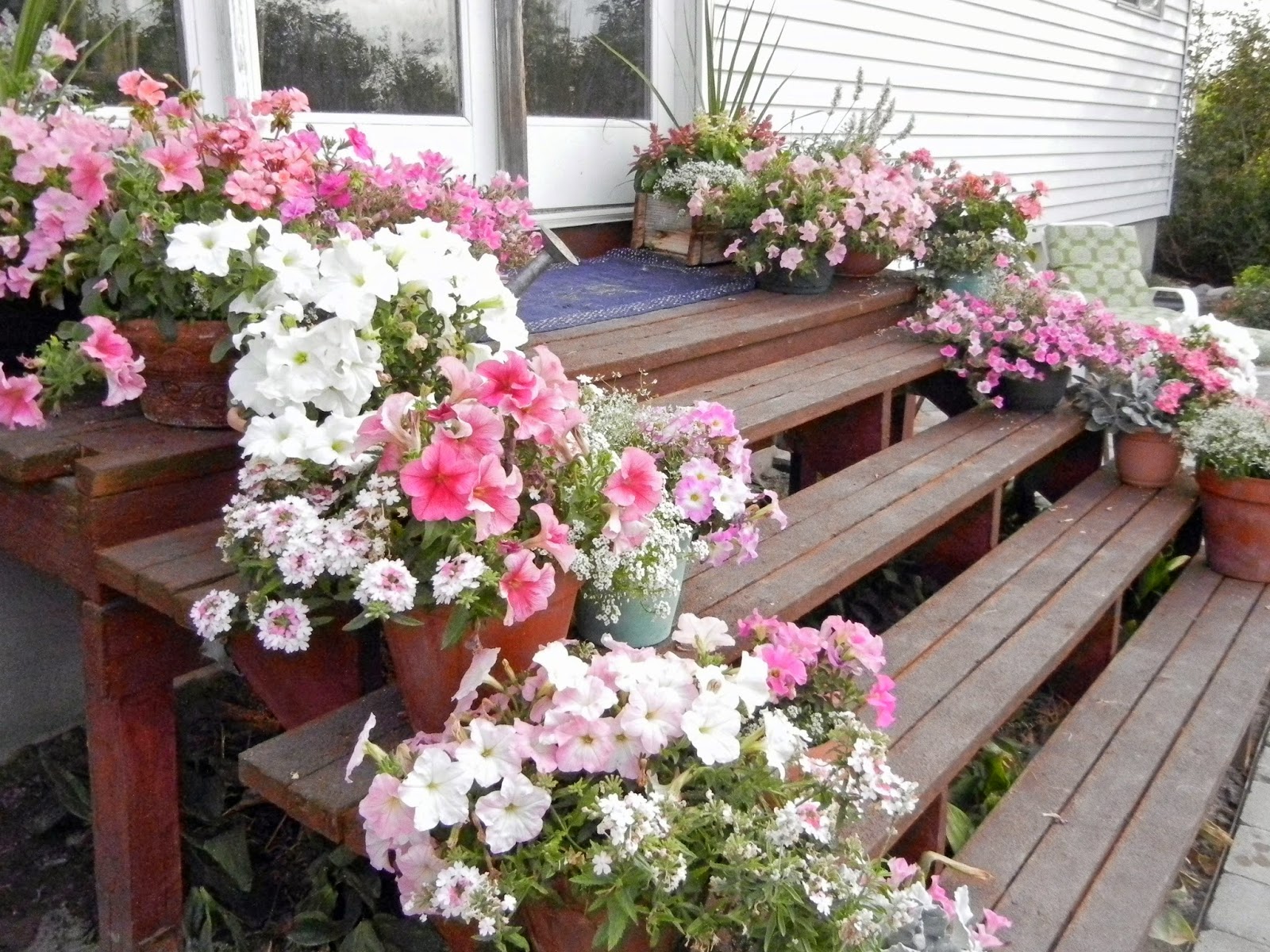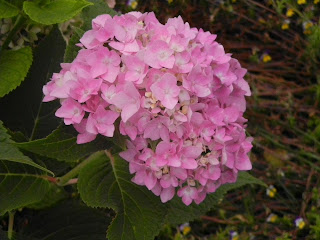Getting Ready for a Wedding--Rejuvenating Flowerpots
When my daughter told us she wanted to have her wedding reception in our yard in September, I knew there wouldn't be many of my perennial plants and bushes in bloom at that time of year. So whenever anyone asked if they could do anything to help me with the wedding, I replied, "Plant pink and coral flowers in your pots." I did the same. These pots will add much needed color to the yard for the wedding.
As you can see from this picture taken last week, the pots are looking gorgeous, which would be great if the wedding were today. But there is still a month until the wedding. By then the flowerpots could be looking straggly and spent. I decided it was time to take action to make sure that didn't happen.
First I tackled pruning the flowers in the pots. When we hear the term "pruning" we usually think of trees and shrubs. But the deadheading and pinching back we do on herbaceous plants (plants with green, soft tissue rather than woody tissue) is also a form of pruning. And the first principle you need to understand in pruning is that pruning stimulates growth. If you understand how a plant grows, you can use that knowledge in pruning to get the plant to grow the way you want it to.
Here's a "before" shot of the first pot I pruned.
Notice how long the branches of petunias are becoming. If I just let them go, they'd really become spindly. So these needed to be cut back.
In any plant, the growing points are the points where buds, leaves, and branches form. The bud at the tip of the branch, called the apical bud, has dominance. This means most of the plants energy will go into it, making the branch grow longer. When the apical bud is removed, buds behind it along the stem will then begin to grow more. This is why pinching back a plant makes the plant grow bushier.
Since I want my petunias to become bushier, not longer, I need to remove the apical buds. I do this by cutting back the stems to another growing point. I chose one where I saw a lot of new growth.
To deadhead petunias, cut behind the entire flower head. If you simply pull on the petals, they will come off, but the flower's ovary (the bulge at the base of the flower) will remain. This is where the seeds form. If the flower has been pollinated, seeds will still form there even if the petals are gone.
You might notice that I am using small pruners to make the cuts. You can deadhead by simply pinching off the flower with your fingers. However, I find that when I do that, I sometimes pull too hard and pull the plant out of the soil. If you're more gentle than me, go ahead and use your fingers. But if you want to be safe, use pruners or garden shears.
To deadhead geraniums, cut back the entire stem. If you just cut off the flower head, that would leave unsightly stems sticking out.
One thing to note, I removed any flower that was beginning to fade at all because I want to encourage a lot of new flowering for later. Normally I wouldn't remove the flowers until they had completely faded.
Here is the first pot after I finished pruning it. It is still attractive, but much more compact.
Here's how to prune one of my favorite flowers for pots--trailing verbena.
Trailing verbena comes in tons of colors and blooms heavily all summer. When you prune it, or any flower for that matter, look to see where new growth or new flower buds are forming. Once you've found the new growth, cut back to that point.
Here's the "after" shot of the second pot I pruned. Notice the verbena on the left.
The fertilizer above is high in nitrogen--the first number. The fertilizer below is high in phosphorus--the second number.
Phosphorus promotes root and flower growth. If you want to encourage flower formation, choose a fertilizer where the second number is the highest. It doesn't matter if the label says it is for roots or roses or whatever. If it's high in phosphorus, it will promote flowering.
For my pots, I wanted to promote both new growth and flowering, so I wanted a balanced fertilizer with high amounts of both nitrogen and phosphorus. I could have run to the store and purchased one, but I already had the two fertilizers shown above. So I simply diluted both at the appropriate level then mixed them together to make my own balanced fertilizer.
I will continue to deadhead and fertilize my pots over the next month, and if all goes as planned and we don't get an early frost, they will still be at their peak for the wedding.
As you can see from this picture taken last week, the pots are looking gorgeous, which would be great if the wedding were today. But there is still a month until the wedding. By then the flowerpots could be looking straggly and spent. I decided it was time to take action to make sure that didn't happen.
First I tackled pruning the flowers in the pots. When we hear the term "pruning" we usually think of trees and shrubs. But the deadheading and pinching back we do on herbaceous plants (plants with green, soft tissue rather than woody tissue) is also a form of pruning. And the first principle you need to understand in pruning is that pruning stimulates growth. If you understand how a plant grows, you can use that knowledge in pruning to get the plant to grow the way you want it to.
Here's a "before" shot of the first pot I pruned.
Notice how long the branches of petunias are becoming. If I just let them go, they'd really become spindly. So these needed to be cut back.
In any plant, the growing points are the points where buds, leaves, and branches form. The bud at the tip of the branch, called the apical bud, has dominance. This means most of the plants energy will go into it, making the branch grow longer. When the apical bud is removed, buds behind it along the stem will then begin to grow more. This is why pinching back a plant makes the plant grow bushier.
Since I want my petunias to become bushier, not longer, I need to remove the apical buds. I do this by cutting back the stems to another growing point. I chose one where I saw a lot of new growth.
Next I removed all of the spent flowers, which is called "deadheading". Plants have one purpose--to pass their DNA on to the next generation. They do this by producing seeds. Flowers are their reproductive organs where this takes place. If the flowers are removed before they have the chance to produce seed, the plant will put a lot of energy into making more flowers. Even many perennials, which don't generally flower as heavily as annuals, will put on a second flush of flowers if they are deadheaded before they go to seed.
You might notice that I am using small pruners to make the cuts. You can deadhead by simply pinching off the flower with your fingers. However, I find that when I do that, I sometimes pull too hard and pull the plant out of the soil. If you're more gentle than me, go ahead and use your fingers. But if you want to be safe, use pruners or garden shears.
To deadhead geraniums, cut back the entire stem. If you just cut off the flower head, that would leave unsightly stems sticking out.
One thing to note, I removed any flower that was beginning to fade at all because I want to encourage a lot of new flowering for later. Normally I wouldn't remove the flowers until they had completely faded.
Here is the first pot after I finished pruning it. It is still attractive, but much more compact.
Here's how to prune one of my favorite flowers for pots--trailing verbena.
Trailing verbena comes in tons of colors and blooms heavily all summer. When you prune it, or any flower for that matter, look to see where new growth or new flower buds are forming. Once you've found the new growth, cut back to that point.
 |
| before pruning |
 |
| after pruning |
Here's the "after" shot of the second pot I pruned. Notice the verbena on the left.
After I pruned the pots, it was time to fertilize them. When I planted the pots I mixed a slow release, granular fertilizer into the soil. Now that the pots have filled in it would be difficult to mix more granular fertilizer into the soil without disturbing the flowers. So I decided to use a liquid or water soluble fertilizer.
When you go to the store to purchase fertilizer, you will see formulations for all kinds of purposes--lawns, roots, flowers, even specific flowers like roses. It can be confusing. Let me simplify it for you. Fertilizers contain three main elements--nitrogen, phosphorus, and potassium--in different percentages. These are abbreviated as N-P-K. Labels will sometimes actually include N-P-K, but normally you just see three numbers representing them.
 |
| On this label, I added the N-P-K. Normally you would just see the numbers.
|
Nitrogen promotes new growth. If you want a lot of new green growth, choose a fertilizer where the first number is the highest. It doesn't really matter if the label says it is for your lawn or your vegetable garden or whatever. If it's high in nitrogen, it will promote new growth.Phosphorus promotes root and flower growth. If you want to encourage flower formation, choose a fertilizer where the second number is the highest. It doesn't matter if the label says it is for roots or roses or whatever. If it's high in phosphorus, it will promote flowering.
For my pots, I wanted to promote both new growth and flowering, so I wanted a balanced fertilizer with high amounts of both nitrogen and phosphorus. I could have run to the store and purchased one, but I already had the two fertilizers shown above. So I simply diluted both at the appropriate level then mixed them together to make my own balanced fertilizer.
I will continue to deadhead and fertilize my pots over the next month, and if all goes as planned and we don't get an early frost, they will still be at their peak for the wedding.













Comments
Post a Comment